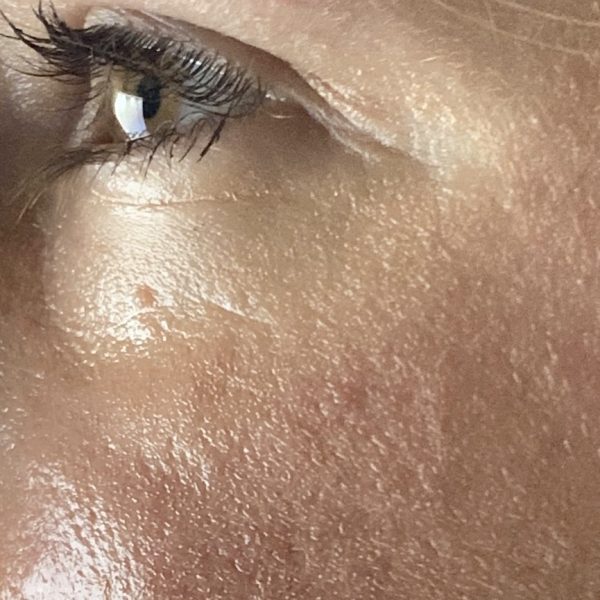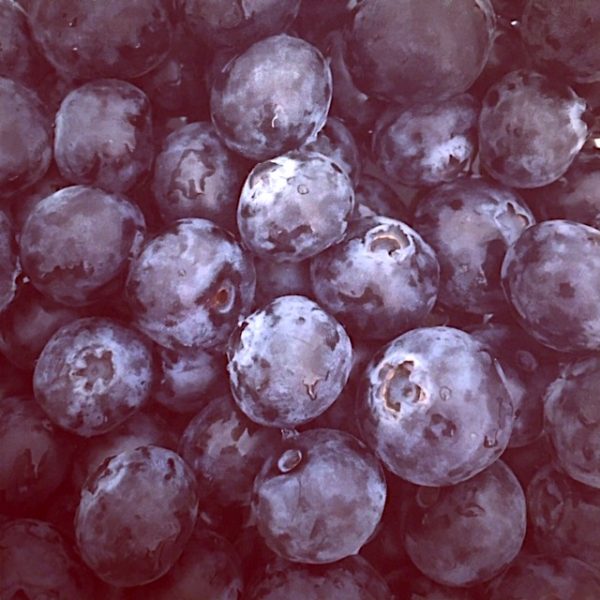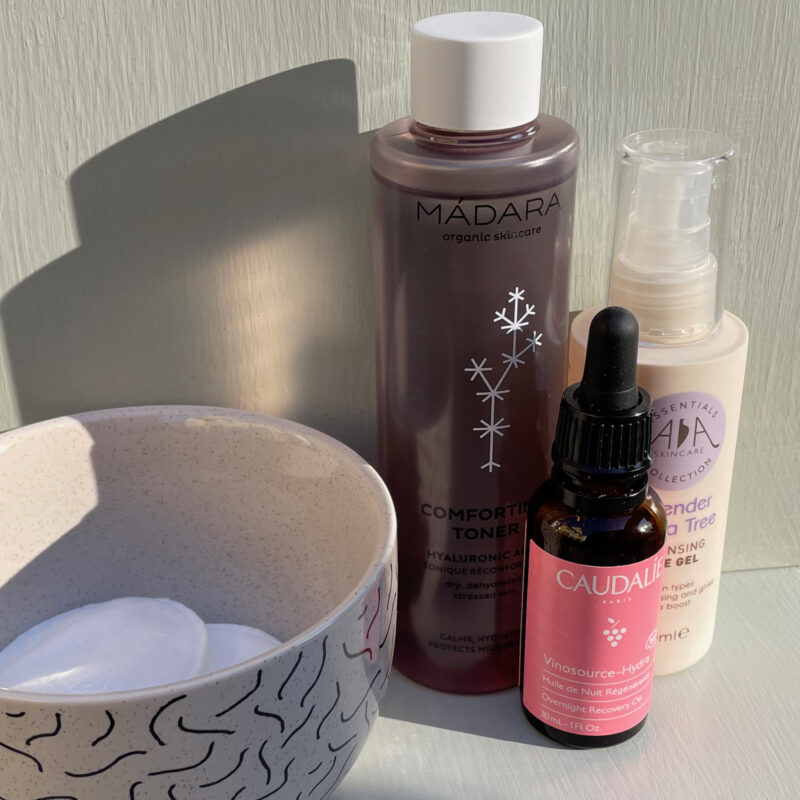What Is Rosacea?
Rosacea can be defined as a chronic inflammatory skin condition and categorised into four subtypes.
Subtype 1 – Erythematotelangiectatic
Subtype 2 – Papulopustular
Subtype 3 – Phymatous
Subtype 4 – Ocular
Erythematotelangiectatic rosacea is characterised by flushing and persistent redness, specifically in the midsection of the face. Blood vessels may also be visible in addition to skin irritation, sensitivity dryness and thickened skin. This subtype can often be hard to treat with conventional medical treatments, and as there is no cure, the focus often leans towards controlling symptoms of facial flushing and redness. As stated by the National Rosacea Society, identifying and minimising exposure to lifestyle and environmental triggers can be helpful in controlling symptoms associated with this subtype. Demographically, this form is most likely to affect young women; however, it is even more prevalent during middle age. For further information on this subtype, see ‘Erythematotelandiectatic Rosacea’.
Papulopustular rosacea presents itself as acne-like breakouts, which refers to ‘papules’ and ‘pustules’. In addition to red spots and bumps, symptoms of this subtype include those associated with typical rosacea, such as facial redness, stinging, itching and burning.
The third subtype, phymatous rosacea, results in an enlarged nose due to excess tissue, known as rhinophyma.
The final subtype, ocular rosacea, often affects both eyes, although the involvement in one eye is not uncommon and is associated with eye irritation, itchiness, redness and inflamed eyelids; referred to as ‘blepharitis’. Eyelid swelling results in a shiny appearance and the feeling of a foreign object under the eyelid. A bloodshot appearance of the sclera (white part of the eye) can also occur. I find ocular rosacea only flares up when stressed. I can feel changes in my eyes even before any visible symptoms appear. The best way to describe it would be a feeling of pressure, combined with a dull pain across my eyelid. Stress contributes to this subtype by negatively affecting the immune system. A medically in-depth article exists in the scientific journal Clinical and Experimental Ophthalmology by the Royal Australian and New Zealand College of Ophthalmologists.
For further information on rosacea subtypes in general, look at the article ‘Rosacea: A Misunderstood, Serious Medical Condition’.

![]() Rosacea Causes and Triggers
Rosacea Causes and Triggers
There is no definitive answer concerning the causes however is thought to be a combination of environmental and hereditary factors. Although the specific cause is unknown, inflammation has been considered the root cause of skin conditions. On a deeper level, an over-active immune system plays a role in skin conditions, particularly rosacea. This topic will be addressed in-depth in future posts as it warrants further explanation.
Rosacea triggers are wide-ranging – from sunlight exposure, food intolerances, spicy foods, alcohol consumption, hot drinks and food, hormonal changes, temperature fluctuations (going from cold to hot environments or vice versa), sensitivity to skincare ingredients and emotional stress. Physical stress from intense exercise can also contribute towards a rosacea flare-up.
There is a link between psychological stress and rosacea, referred to as ‘psychosomatic rosacea’. This component of the skin condition is known as a field of dermatology, referred to as ‘psychodermatology’. I have covered this topic in a later article entitled ‘Psychodermatology – Is There a Connection Between the Mind and Skin?‘. For information on the influence of psychological factors on skin conditions and their management, see this article.
I have adapted to deal with triggers which include keeping emotional stress to a minimum, keeping my face out of direct sunlight as much as possible (I use sun protection every day), and allowing hot drinks to cool before drinking. Nowadays, I can tolerate spicy food, but at one time, I had to cut back on all spices to avoid a flare-up. At my worst, even eating a hot meal would induce immediate flushing and uncomfortable sensations of heat on my face.

Diagnosing Rosacea
Rosacea is diagnosed via a physical examination as the symptoms are physically noticeable. The potential issue is the risk of being misdiagnosed with other conditions, such as lupus, an autoimmune disease, often presenting itself in a red, butterfly-shaped rash across the cheeks. Lupus, however, has many wide-ranging symptoms aside from a facial rash, whereas rosacea does not. For more information about the differences between the two conditions, this article is available.
Treating Rosacea
Concerning rosacea treatments, there have been advancements over the past ten years. At the time of diagnosis, antibiotics (Tetracycline) and topical gel (Rozex Gel) were the prescribed treatments. I took it daily for over a year and applied the gel twice per day. Despite being regarded as an effective rosacea treatment, unfortunately, my symptoms were exacerbated, resulting in increased redness, bumpy texture, stinging, burning, and itching. The lack of improvement inspired me to find alternatives, in the hope of relieving and improving my skin. With the advancement in modern medicine, the prescribed treatment options include various new oral medications plus laser and light therapy.
Alternative and non-medicinal rosacea treatments, in my opinion, require a ‘whole’ approach. Aspects such as dietary changes, opting for natural and non-toxic skincare products, and adopting practices to aid stress relief, with the overall goal of reducing internal inflammation, is the key to improving symptoms. Although there is no cure, it is possible to improve one’s skin through lifestyle alterations. Given my experience, I wholly support going down the more natural route rather than relying on typical medical interventions. The evidence behind adopting an anti-inflammatory lifestyle to improve rosacea is available here.

Decreasing Internal Inflammation
Modifying lifestyle factors can reduce the impact of chronic inflammation. These include:
- Diet – Food and drink contributes towards inflammation; reducing pro-inflammatory foods such as processed food, red meat, fried foods, dairy products, and food with a high sugar content can help reduce inflammation. Antioxidant-rich fruits and vegetables, such as cruciferous vegetables (broccoli, kale) and berries, help to decrease inflammation. Opting for healthier sources of fat (unsaturated fat) such as olive oil rather than butter is a favourable swap. Anti-inflammatory omega-3 fatty acids found in fish (salmon, preferably wild), mackerel, tuna and cold-water fish and lean meats, for example, chicken or turkey (preferably organic), are all healthy sources of protein providing inflammation-reducing properties.
- Exercise – Increasing physical activity provides multiple benefits, from reducing inflammation (specifically inflammatory markers: C-reactive protein and interleukin 6) to boosting mental well-being. C-reactive protein is the most accurate biological marker for measuring inflammation; when present within the body, the liver secretes the protein, which is measurable via a blood test.
- Stress – Reducing stress goes a long way to decreasing internal inflammation. Without adequate stress relief, cortisol accumulates. Information can be found here on lowering cortisol.
- Sleep – Adequate sleep is key to keeping internal inflammation under control. As stated in ScienceDaily, sleep deprivation results in the activation of the main cellular pathway, which causes damaging inflammation.
- Toxins – Swapping products for natural and organic alternatives is hugely beneficial. Rosacea-prone skin is sensitive and reactive, with many skincare products containing many irritants. Using natural and organic products reduces the likelihood of exposure and decreases the overall toxic load. Reducing inhaled toxins through improved air quality also contributes towards lowering internal inflammation.
Abokwidir, M. and Feldman, S. (2016) ‘Rosacea Management’, Skin Appendage Disorders, vol. 2, pp. 26-34 [Online].
Available At: https://www.ncbi.nlm.nih.gov/pmc/articles/PMC5096126/
Accessed: (24 June 2021).
Bedinghaus, T. (2020) ‘Causes and Risk Factors of Flaky Eyelids’, [Online].
Available At: https://www.verywellhealth.com/dealing-with-flaky-eyelids-3421984
Accessed: (24 June 2021).
Black, J. (2018) ‘Chronic Inflammation? Here’s How Altering Your Lifestyle Can Help’, [Online].
Available At: https://universityhealthnews.com/daily/pain/chronic-inflammation-altering-your-lifestyle-can-help/
Accessed: (24 June 2021).
Davidson, K. (2021) ’11 Natural Ways To Lower Your Cortisol Levels’, [Online].
Available At: https://www.healthline.com/nutrition/ways-to-lower-cortisol
Accessed: (29 June 2021).
Drake, L. (2010) ‘Subtype 1 Rosacea Needs Special Care’, National Rosacea Society: Rosacea Review. [Online].
Available At: https://www.rosacea.org/rosacea-review/2010/summer/subtype-1-rosacea-needs-special-care
Accessed: (24th June 2021).
Elsevier (2008) ‘Loss Of Sleep, Even For A Single Night, Increases Inflammation In The Body’, Science Daily, [Online].
Available At: https://www.sciencedaily.com/releases/2008/09/080902075211.htm
Accessed: (27 June 2021).
Helwick, C. (2013) ‘Rosacea: A Misunderstood, Serious Medical Condition’, American Health & Drug Benefits. [Online].
Available At: https://ahdbonline.com/payer-perspectives-in-dermatology/1469-article-1469
Accessed: (24 June 2021).
International Health Research (2012) ‘How to Dramatically Reduce Inflammation: A Primary Source of Disease and Ageing’, All Health Watch, Anti-Ageing. [Online].
Available At: https://www.institutefornaturalhealing.com/2012/05/how-to-dramatically-reduce-inflammation-a-primary-cause-of-disease-and-aging/
Accessed: (27 June 2021).
Khan, N. (2020) ‘Can Rosacea Be Cured? New Treatments and Research’, [Online].
Available At: https://www.healthline.com/health/rosacea/research-cure-update
Accessed: (27 June 2021).
Levy, J. (2018) ‘Rosacea Treatment: 6 Natural Ways To Treat Your Skin’, [Online].
Available At: https://draxe.com/health/rosacea-treatment/
Accessed: (29 June 2021).
Marchione, V. (2016) ‘Lupus vs Rosacea: Differences in symptoms, causes, and treatment’, [Online].
Available At: https://www.belmarrahealth.com/lupus-vs-rosacea-differences-in-symptoms-causes-and-treatment/
Accessed: (29 June 2021).
National Rosacea Society (n.d.) ‘Causes of Rosacea: Innate Immune System’, [Online].
Available At: https://www.rosacea.org/patients/causes-of-rosacea/innate-immune-system
Accessed: (29 June 2021).
‘Ocular Rosacea Blepharitis’, (n.d.) [Online].
Available At: https://rosacea-ltd.com/blepharitis/
Accessed: (24 June 2021).
Purohit, M. (2018) ‘Erythematotelangiectatic Rosacea’, DoveMed [Online].
Available At: https://www.dovemed.com/diseases-conditions/erythematotelangiectatic-rosacea/
Accessed: (24 June 2021).
Shenefelt, P. (2021) ‘Management of Psychodermatologic Disorders’, Dermatology Nursing, [Online].
Available At: https://www.medscape.com/viewarticle/730033_2
Accessed: (27 June 2021).
Sitohang, IBS., Parrol, F., Fitri, E.M. and Nora, R. (2021) ‘Papulopustular and Ocular Rosacea with an Alleged Coincidence of Cutaneous Lupus Erythematosus: A Case Report’, Case Reports in Dermatology, vol. 13, pp. 62–68 [Online].
Available At: https://europepmc.org/article/PMC/PMC7923712#free-full-text
Accessed: (27 June 2021).
Situm, M., Kolic, M. And Buljan, M. (2016) ‘Psychodermatology’, Acta Medica Croatia, vol. 70, pp. 35-38 [Online].
Available At: https://pubmed.ncbi.nlm.nih.gov/29087669/
Accessed: (27 June 2021).
Tavassoli, S., Wong, N. And Chan, E. (2021) ‘Ocular Manifestations of Rosacea: A Clinical Review’, Clinical & Experimental Ophthalmology. Special Issue: The Eye and Systemic Disease, vol 49 (2), pp. 104-117 [Online].
Available At: https://onlinelibrary.wiley.com/doi/epdf/10.1111/ceo.13900
Accessed: (29 June 2021).
